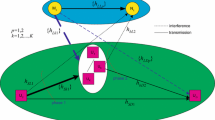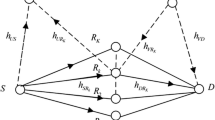Abstract
In this study, we investigate the outage capacity of a cooperative relaying based cognitive radio network in slow fading channel. Our network scenario consists of a primary transmitter (PT) and primary receiver (PR) as well as a group of \(M\) secondary transmitter (ST)–receiver (SR) pairs. We grouped STs into active and inactive. Only one active ST may transmit data at a time in parallel with the PT satisfying a predefined interference threshold \(I_{th}\) to the PR. Due to fading/shadowing or interference caused by ST to the PR, primary user (PU) may fail to achieve its target rate \(R_{{\textit{PT}}}\) over a direct link. To overcome this, we can boost up primary capacity by using inactive STs as cooperative relay (Re) nodes for the PU. In addition, one of the inactive STs that achieves \(R_{{\textit{PT}}}\) will be act as a best decode-and-forward relay to forward the primary information. In this paper, a closed-form expression of the outage capacity is derived. Results show that outage capacity improves with increasing cooperative nodes as well as when the active ST is located farther away from the PR.






Similar content being viewed by others
References
Haykin, S. (2005). Cognitive radio: Brain-empowered wireless communications. IEEE Journal on Selected Areas in Communications, 23(2), 201–220.
Devroye, N., Vu, M., & Tarokh, V. (2008). Cognitive radio networks. IEEE Signal Processing Magazine, 25(6), 12–23.
Ghasemi, A., & Sousa, E. S. (2007). Fundamental limits of spectrum-sharing in fading environments. IEEE Transactions on Wireless Communications, 6(2), 649–658.
Kang, X., Liang, Y.-C., Nallanathan, A., Garg, H. K., & Zhang, R. (2009). Optimal power allocation for fading channels in cognitive radio networks: Ergodic capacity and outage capacity. IEEE Transactions on Wireless Communications, 8(2), 940–950.
Woradit, K., Quek, T. Q. S., Suwansantisuk, W., Win, M. Z., Wuttisittikulkij, L., & Wymeersch, H. (2009). Outage behavior of selective relaying schemes. IEEE Transactions on Wireless Communications, 8(8), 3890–3895.
Asaduzzaman, & Kong, H. Y. (2011). Ergodic and outage capacity of interference temperature-limited cognitive radio multi-input multi-output channel. IET Communications, 5(5), 652–659.
Musavian, L., & Aissa, S. (2007). Ergodic and outage capacities of spectrum-sharing systems in fading channels. In Proceedings of IEEE global telecommunications conference (GLOBECOM’07), pp. 3327–3331.
Xie, R., Yu, F. R., & Ji, H. (2012). Outage capacity optimisation for cognitive radio networks with cooperative communications. IET Communications, 6(11), 1519–1528.
Wang, H., Lee, J., Kim, S., & Hong, D. (2010). Capacity enhancement of secondary links through spatial diversity in spectrum sharing. IEEE Transactions on Wireless Communications, 9(2), 494–499.
Kader, M. F., Asaduzzaman, & Chowdhury, M. (2012). Cooperative secondary user selection as a relay for the primary system in underlay cognitive radio networks. In Proceedings of IEEE 15th international conference on computer and information technology (ICCIT’12), pp. 275–278.
Rappaport, T. S. (2001). Wireless communications: principles and practice (2nd ed.). Prentice: Prentice Hall PTR.
Papoulis, A. (1991). Probability, random variables, and stochastic processes. New York: Mcgraw-Hill.
Lien, S.-Y. Tseng, C.-C. & Chen, K.-C. (2008). Carrier sensing based multiple access protocols for cognitive radio networks. In Proceedings of the IEEE international conference on communications (ICC), pp. 3208–3214.
Kim, H., Lim, S., Wang, H., & Hong, D. (2012). Optimal power allocation and outage analysis for cognitive full duplex relay systems. IEEE Transactions on Wireless Communications, 11(10), 3754–3765.
Bletsas, A., Shin, H., & Win, M. Z. (2007). Cooperative communications with outage-optimal opportunistic relaying. IEEE Transactions on Wireless Communications, 6(9), 3450–3460.
Kader, M. F., Asaduzzaman, & Hoque, M. M. (2013). Hybrid spectrum sharing with cooperative secondary user selection in cognitive radio networks. KSII Transactions on Internet and Information Systems, 7(9), 2081–2100.
Zhang, J., & Zhang, Q. (2009). Stackelberg game for utility-based cooperative cognitive radio networks. In ACM MOBIHOC, pp. 23–32.
Author information
Authors and Affiliations
Corresponding author
Rights and permissions
About this article
Cite this article
Kader, M.F., Asaduzzaman & Hoque, M.M. Outage Capacity Analysis of a Cooperative Relaying Scheme in Interference Limited Cognitive Radio Networks. Wireless Pers Commun 79, 2127–2140 (2014). https://doi.org/10.1007/s11277-014-1976-8
Published:
Issue Date:
DOI: https://doi.org/10.1007/s11277-014-1976-8




